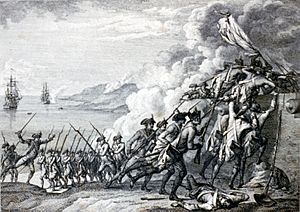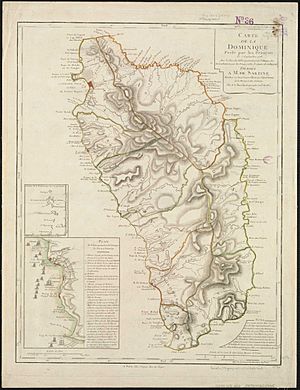Invasion of Dominica (1778) facts for kids
Quick facts for kids Invasion of Dominica |
|||||||
|---|---|---|---|---|---|---|---|
| Part of the American Revolutionary War | |||||||
 Prise de la Dominique, engraving by François Godefroy |
|||||||
|
|||||||
| Belligerents | |||||||
| Commanders and leaders | |||||||
| François Claude Amour, marquis de Bouillé | William Stuart |
||||||
| Strength | |||||||
| 2,000 men 3 frigates 1 corvette smaller vessels and transports |
100–600 men (regulars and militia) | ||||||
| Casualties and losses | |||||||
| at least 40 | 2 killed; remainder surrendered | ||||||
The Invasion of Dominica happened on September 7, 1778. It was a successful attack by France on the island of Dominica. Dominica was a British island in the West Indies. This event took place during the American Revolutionary War.
At the time, British leaders in the Caribbean did not know that France had joined the war. France was now an ally of the United States of America. The French governor in the West Indies, François Claude Amour, marquis de Bouillé, learned about the war on August 17. He quickly planned the invasion. He even sent spies to get help from French-speaking people on Dominica.
Early on September 7, 1778, French soldiers landed on the island's southeast coast. They quickly took over some of Dominica's defenses. Soon, they controlled the high ground above Roseau, the capital city. Lieutenant Governor William Stuart then surrendered his remaining forces. Dominica stayed under French control until the war ended. It was then given back to Britain.
Why Dominica Was Invaded
After the important Battles of Saratoga in October 1777, British General John Burgoyne's army surrendered. This led France to openly join the American War of Independence. France became an ally of the new United States.
France wanted to get back lands it had lost to Britain in the Seven Years' War. One key place they wanted was Dominica. This island was in the West Indies. It was located between French-held Martinique and Guadeloupe. Britain had captured Dominica in 1761. Taking it back would make it easier for French islands to communicate. It would also stop British privateers from using Dominican ports to attack French ships.
On Dominica, Governor Thomas Shirley worried about the island's safety. He had been concerned since the war started in 1775. He worked to improve a fort at Cachacrou and other places. He did this even though London told him to keep defense costs low. This work was not finished when Shirley left for England in June 1778. Lieutenant Governor William Stuart was left in charge. The defenses were still not complete in August 1778. That's when François Claude Amour, marquis de Bouillé, the French governor, heard that war had begun.
Planning the Attack
The French ship Concorde arrived in Martinique on August 17. It carried orders from Paris to capture Dominica as soon as possible. De Bouillé immediately started planning. He had kept in touch with people on Dominica. Many people there were French, including free people of color. Because of this, he knew a lot about Dominica's defenses. He knew the island's army had fewer than "fifty soldiers ready for duty."
De Bouillé also worried about the British fleet led by Admiral Samuel Barrington. Barrington's fleet was much stronger than his own. But de Bouillé didn't know that Barrington had orders to keep most of his ships at Barbados. He had to wait for more instructions. The British soldiers on Dominica, about 100 in total, were spread out. They were in defenses in Roseau, the capital, in the hills above it, and at Cachacrou.
De Bouillé pretended to be peaceful with Dominican leaders. At the same time, he prepared his forces on Martinique. On September 2, he and Stuart signed an agreement. It officially stopped privateer crews from stealing. The next day, de Bouillé sent an officer to Dominica. He wanted to see if a Royal Navy ship was still in Prince Rupert's Bay. Stuart suspected the man. He questioned him, then let him go. On September 5, de Bouillé learned the ship had sailed for Barbados.
He immediately launched his invasion. Some Frenchmen entered the fort at Cachacrou that evening. They gave the soldiers there drinks. Then, they poured sand into the cannons' touchholes. This made the cannons useless for a short time. De Bouillé had also sent agents to the island. These agents convinced some local French-speaking soldiers to not show up for duty when called.
The Invasion Begins
After sunset on September 6, 1,800 French soldiers and 1,000 volunteers left Martinique. They sailed on three frigates: Tourterelle, Diligente, and Amphitrite. They also had the corvette Étourdie and many smaller boats.
The first target was the fort at Cachacrou. The British soldiers there were confused by drinks. Their cannons didn't work. The French easily took over the fort around dawn on September 7. Two soldiers from the 48th Regiment of Foot fell to their deaths. After securing the fort, the French fired cannons and sent signal rockets. This was to signal their allies. These actions also alerted Stuart in Roseau. The alarm was raised right away. Many of the French Dominican soldiers did not show up, as planned. About 100 soldiers did show up. They were sent to defend Roseau.
The French then landed more troops between Cachacrou and Roseau. Their goal was to reach the high ground above the capital. The main force of 1,400 men landed about 2 miles (3.2 km) south of Roseau near Pointe Michel. Heavy fire from the hill defenses caused 40 French casualties. De Bouillé landed with another 600 men at Loubiere, between Pointe Michel and Roseau. Another 500 landed north of Roseau. The French ships moved to attack Roseau's defenses.
The French briefly captured the fort at Loubiere. But they were driven out three times by fire from above. They pulled back until their forces could reach and capture the hill defenses. By noon, the French controlled the high ground above the capital. Stuart realized he could not win.
Negotiations followed. Stuart and de Bouillé signed the surrender terms around 3:00 pm. The process was interrupted by one of the French frigates. Its captain, not knowing about the surrender, fired on Fort Young. The British flag was still flying there. The two commanders rushed to the fort to stop more shooting. After that, they finished the agreement. The French then officially took control of Roseau. The British soldiers became prisoners of war. The local soldiers were allowed to go home. De Bouillé wanted to stay on good terms with the people. So, he did not let his troops steal from the town. Instead, he charged the island's people a fee of £4,400. This money was given to his men.
What Happened Next
De Bouillé officially said the French had no casualties. Stuart reported that the French seemed to be hiding their losses. De Bouillé left 800 soldiers on the island. These included 700 French soldiers and 100 local soldiers. He gave command to the Marquis de Duchilleau. Then, de Bouillé returned to Martinique.
News of Dominica's fall surprised London. People thought that just one warship could have stopped the attack. Admiral Barrington was widely blamed for the loss. He was criticized for following his orders too strictly. His orders and reinforcements had kept him at Barbados. They were meant for an attack on St. Lucia. He carried out this plan in December 1778, taking St. Lucia. These events were the first of many where Caribbean islands changed hands during the war. De Bouillé was often involved in these actions.
Dominica stayed under French control until 1784. De Bouillé was annoyed when it was returned to British control. This happened under the terms of the 1783 Treaty of Paris. The fact that the French had given weapons to local people caused problems for the British. These local forces had been peaceful before. But now they fought against British attempts to expand their land on the island. This led to more conflict in 1785.




